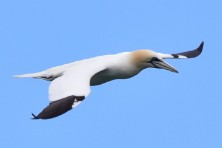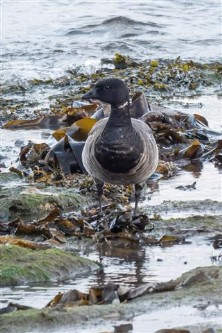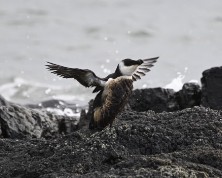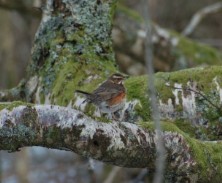October 2024
Bird Sightings



The weather in October was unsettled and often overcast with one named storm. October is arguably the busiest birding month, as summer breeders depart, migrants pass through, winter visitors arrive and there is always a strong chance of something unusual. This October did not disappoint.
The passage of Storm Ashley resulted in a reports of oceanic species, Guillemot and Razorbill, seeking respite on a number of headlands round the island including unusually an oiled Razorbill at Drumadoon Point on 22 October and an oiled Guillemot in Kildonan on 24th.
Winter visitors arriving included: fifty Pink-footed Geese flying over Kildonan on 2nd, six Wigeon on Cleats Shore on 3rd, twenty Teal in Sliddery on 7th, two Brent Geese in Kildonan on 12th, one hundred Greylag Geese in the Shiskine Valley also on 12th, fifteen Rook on Cleats Shore on 13th, a male Blackcap in Lagg on 15th, one Brambling in Sliddery on 30th and thirteen Whooper Swan resting on Mossend Pond on 31st, In October Redwing and Fieldfare both arrived in numbers. The first report of Redwing was on 9th and the first report of Fieldfare was later on 30th. The largest group of Redwing reported was eight hundred at Sliddery on 30th and the largest group of Fieldfare was one hundred at Machriewaterfoot on 31st.
Migration was in full flow in October as birds were moving out of colder northern Europe to milder climes. These included: forty-five Meadow Pipit on Cleats Shore on 3rd, three Dunlin Blackwaterfoot on 4th, one hundred and seventy Ringed Plover in Whiting Bay on 5th, one Whimbrel in Pirnmill on 7th, seven Twite, sixty Skylark and one hundred and twenty-five Linnet on Cleats Shore on 13th, one hundred and fifty Lesser Redpoll in Kilmory Forest also on 13th, fifty Golden Plover in Sliddery on 17th, one hundred Kittiwake off Pirnmill on 21st, a Black-tailed Godwit at Torrylinnwater Foot on 23rd, a male Merlin in Sliddery on 25th , eleven Lapwing and twenty Turnstone on Sliddery Shore on 30th.
There were some “last sightings” of summer visitors also moving south including: two Lesser Black-backed Gull at Drumadoon Point on 3rd, one White Wagtail on Cleats Shore also on 3rd, one Wheatear in Machrie Bay on 7th, one Chiffchaff in Sliddery also on 7th and Gannet were reported throughout the month including one off Pirnmill on 31st. In addition, the last reports of House Martin were both on 1st with four at Laigh Kilmory and one in Feorline. The largest group of Swallow in October was fourteen in Sliddery on 9th and the last report was one Sliddery on 12th .
Other interesting records, from a month with over one hundred species reported, included: one White-tailed Eagle in Glen Rosa on 3rd, twelve Red-breasted Merganser in Catacol Bay on 8th, three Little Grebe in Loch Ranza on 11th, two Goosander in Machriewaterfoot on 12th, one Yellowhammer in Sliddery on 12th, one Great Spotted Woodpecker in Lagg on 15th, two Dipper in North Sannox burn on 18th, twenty-eight Shag at Drumadoon Point on 25th, one Kingfisher in Brodick also on 25th, two Little Egret in Lamlash Bay on 28th and fourteen Common Crossbill in High Kildonan on 31st. Increasingly as winter approaches, Dipper can be seen at the mouth of rivers and burns. In addition, there were reports of all three divers in October including two Great Northen Diver off Cleats Shore on 13th, three Red-throated Diver off Corrie on 18th and five Black-throated Diver off Blackwaterfoot on 29th. Not in time for the September Annual Clyde Eider Survey there were forty Eider off Pirnmill on 25th.
Finally, my thanks to all the “volunteers” who took part in the Eider survey in late September. Coverage this year has again been excellent of not only the main island of Arran but also of Pladda and Holy Isle. As well as shores being walked, some participants did counts from various small boats and kayaks. In addition, for the first time COAST provided RV Coast Explorer to help count round Holy Isle and Lamlash Bay. The result of all these efforts was the lowest count in recent years twenty-two. In 2023 it was fifty-eight. In 2022 it was fifty-five. In 2021 it was forty-five. In 2020 it was seventy-five. In 2000, it was considerably more, at over six hundred. Eider are in decline. For the latest report from Chris Waltho who has been coordinating this research for thirty plus years, visit this website:


